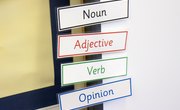Teaching students about grammar can be a challenge for any educator. Understanding sentence structure, however, is one of the most basic fundamentals of the English language. A subject is a noun or pronoun, which is doing the action in a sentence. For example, in the sentence, "The girl is eating an apple," the subject is "the girl." The predicate contains the verb or action that the subject is doing. In the previous sentence, the predicate is "is eating an apple." Practice differentiating subjects and predicates with these fun-learning activities.
Make-a-Sentence Challenge
In this hands-on game, help students to make their own sentences. Write several sentences on a piece of paper. Cut out all the subjects and predicates from each of the sentences. Place all of the pieces of paper in a hat. Have each student draw a paper. Give students 30 seconds to make as many full sentences as they can, using their own subject or predicate. The winner receives a prize.
Multi-Sensory Grammar Lesson
Use colored markers to help students easily visualize the different parts of the sentence. Give each student markers and a worksheet with sentences. Ask the students to circle subjects in red and underline all the predicates in blue. Discuss with students the usual placement of subjects (front) and predicates (end) and the exceptions. You can also use different colors and sentence parts, such as circle green for all nouns, or cross out the verb in yellow. Students can also practice this on the chalkboard.
Dramatic Sentences
Write down several scenes or simple scenarios on a piece of paper, such as: friends going to the movies, winning a baseball game, etc. Have volunteers pick sentences from a hat and act out the scenario without using words. Take turns allowing the audience to guess what kind of scene is being acted out. When an audience participant makes a guess, ask him to make make a complete sentence, such as "Bill is riding a bike." Then ask him to identify the subject and the predicate in the sentence.
Mad Libs
Play this fun version of Mad Libs and come up with some wacky sentences. Come up with a story or use an existing Mad Libs page. For students who are unfamiliar with adverbs or other sentence parts, limit the blanks to just nouns and verbs. Ask students to shout out suggestions for the fill-ins. When finished, recite the Mad Libs aloud to the students. After each sentence, call on a student and ask him which part is the subject and which is the predicate.
Related Articles
Writer Bio
Since 2008, Jen Kim has been a professional writer and blogger, working for national publications such as Psychology Today and Chicago Tribune affiliates. She holds a Master of Science in journalism from Northwestern University.











